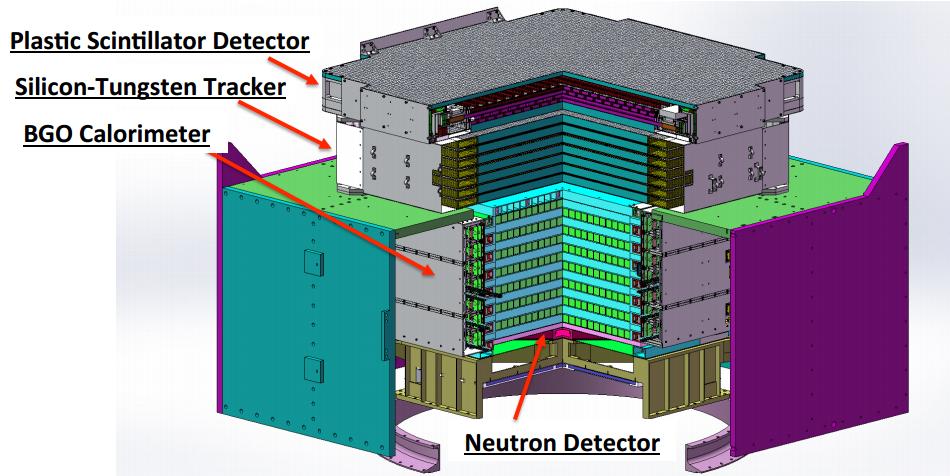The probe, renamed "Wukong" - or Monkey King - shortly before launch, blasted off on a Long March 2D rocket from the Jiuquan Satellite Launch Centre in the Gobi Desert, Inner Mongolia at 00:12 UTC on Thursday, December 17(08:12 Beijing time).
The 1,900 kg satellite was inserted into a sun-synchronous orbit, where it is expected to function for 3 years at an altitude of 500 km.
It will carry out both indirect detection of dark matter and studies into high energy cosmic rays.
The probe, originally known as DAMPE (DArk Matter Particle Explorer), was built in collaboration with the University of Geneva and Italian universities in Bari, Lecce and Perugia. It was then tested at CERN in Switzerland.
Professor Fan Yizhong, a member of the mission team at the Purple Mountain Observatory of the Chinese Academy of Sciences in Nanjing, explained the thinking behind the mission.
“The nature of dark matter is one of the most fundamental questions for the physicists and astrophysicists. It is known that the total mass of the dark matter particles is about five times that of “normal” matter, but no-one really knows what the dark matter particles are.”
“Dark matter particles may annihilate or decay and then produce high energy gamma-rays or cosmic rays - in particular electron/positron pairs.
“DAMPE will measure the spectra of gamma-rays and cosmic rays with very high energy resolution and then look for possible signal of dark matter annihilation or decay.”
Helpfully, DAMPE has the widest observation spectrum and highest energy resolution of any dark matter probe in the world.
Fan says says that as a high energy gamma-ray and cosmic ray detector, Wukong can measure cosmic ray electrons in the energy range of 10 GeV-10 TeV (1GeV=1 billion electron volts; 1 TeV=1000 billion electron volts) and cosmic ray protons and nuclei in the energy range of 100 GeV-a few 100 TeV.
There are four payloads: a plastic scintillator detector, a silicon-Tungsten Tracker, a BGO calorimeter and a neutron detector.
These instruments will variously measure the energy, charge of cosmic rays, converting gamma-rays into electron/positron pairs and then measuring, and distinguishing between electrons and protons or other heavier particles.

The probe will also seek to address the ‘electron/positron anomaly’ found by the collaborative PAMELA and FERMI-LAT satellites and other experiments, in which more positrons – the antimatter version of electrons – have been detected than expected.
With its ability to look for higher energy electrons and positrons, New Scientist writes that DAMPE may be able to determine which of two suspects - dark matter annihilations or pulsars – is responsible for the anomaly.
The probe was renamed via a public competition, with the winning name taken from the famous protagonist in the Chinese story Journey to the West.

Dark matter?
Chris Impey, distinguished professor of astronomy at the University of Arizona, explains that while scientists don't know what dark matter is, they know it is there, and discovering its nature is a question of fundamental importance.
"Evidence started accumulating in the 1970's, when radio and optical data showed that spiral galaxies rotated too rapidly in their outer regions for it to be explained by gravity from the visible stars in the galaxy," Impey says.
"The discrepancy was large, a factor of 5-8. And for a while people doubted the data, but by the late 1980's the evidence had become compelling that some invisible form of matter formed most of the mass of every galaxy astronomers analysed.
"The alternative to dark matter's existence is to say that Newton's law of gravity is wrong and there is no evidence for that on large scales and for weak gravity."
Impey states that, by a process of elimination, dark matter must be a new form of fundamental subatomic particle, with substantial mass and weak or absent interactions with radiation - hence dark.
Dark matter accounts for about a quarter of the universe, Impey notes, with dark energy totalling two-thirds, and normal matter the rest. Dark matter holds galaxies together and dominated the expansion of the universe for most of its early history.
"The dark matter particle is an extension to the otherwise very successful standard model of particle physics, most probably the lightest stable particle in models of supersymmetry.
"But awkwardly for this expectation, the LHC [Large Hadron Collider at CERN] has not affirmed the most likely supersymmetry models, so the battleground has shifted to a set of underground physics detectors trying identify the particle by its occasional and weak interactions with normal matter.
"Hence the intense interest in astronomy missions like DAMPE that have a chance of pinning down dark matter or giving us a clue to its nature. The stakes are very high and it's is one of the biggest unanswered questions in both physics and astronomy."
Fan hopes the mission will provide clues to the nature of dark matter and also help scientists working on cosmic ray physics. To this he adds that some gamma-ray data are expected to be made publicly available a few years after the launch.
For more information about this study,visit the story at
http://gbtimes.com/china/china-launches-worlds-most-sensitive-dark-matter-hunting-probe




